To master epic flyover sequences, you'll need exceptional equipment like high-quality drones, 4K cameras, and wide-angle lenses. Plan your shots meticulously, scouting locations and mapping flight paths. Perfect your drone flight techniques, mastering maneuvers like orbiting and reveal shots. Focus on composition principles, including the rule of thirds and leading lines. Optimize camera settings for cinematic results, and enhance your footage in post-production with color grading and stabilization. Don't forget to research legal considerations and prioritize safety. By honing these skills, you'll create breathtaking aerial cinematography that captivates audiences. The sky's the limit for what you can achieve with these techniques.
Essential Equipment for Flyover Sequences

When it comes to capturing breathtaking flyover sequences, you'll need the right tools for the job. The cornerstone of your equipment arsenal should be a high-quality drone capable of smooth, stable flight. Look for models with advanced stabilization systems and long flight times.
Pair your drone with an excellent camera that offers 4K or higher resolution and a wide dynamic range to capture stunning details in various lighting conditions.
Don't overlook the importance of lens selection. Wide-angle lenses are ideal for showcasing expansive landscapes, while telephoto lenses can create dramatic compression effects. Invest in ND filters to control exposure and achieve cinematic motion blur.
A reliable remote controller with a built-in or attachable monitor is essential for framing your shots and maintaining visual contact with your drone.
For post-production, you'll want powerful editing software capable of handling high-resolution footage and complex color grading. Consider tools like DaVinci Resolve or Adobe Premiere Pro.
Planning Your Flyover Shot

The key to a stunning flyover sequence lies in meticulous planning. Before you take to the skies, scout your location thoroughly. Identify potential obstacles, assess weather conditions, and determine the best time of day for ideal lighting. Consider the story you're trying to tell and how the flyover will enhance it.
Map out your flight path in advance. Visualize the trajectory and speed of your camera movement. Will you start low and gradually ascend, or dive from a high vantage point? Plan for smooth changes between key points of interest in your shot.
Next, secure all necessary permits and permissions. Many locations have strict regulations regarding drone flights or aerial photography. Don't risk your project by overlooking legal requirements.
Coordinate with your team to guarantee everyone understands their role during the shoot. Brief your pilot on the exact movements you need, and make sure your camera operator is prepared to adjust settings mid-flight if necessary.
Mastering Drone Flight Techniques
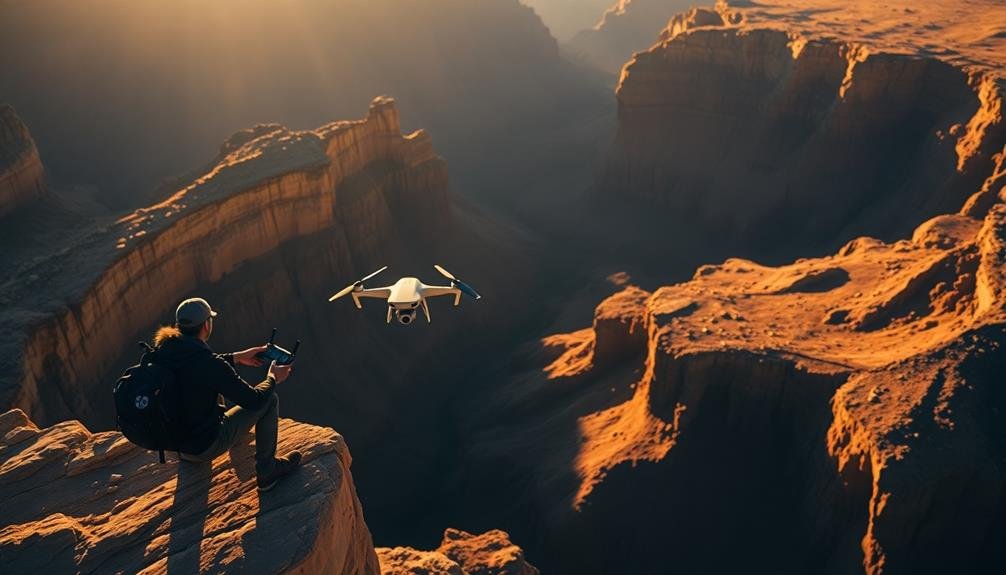
To create truly epic flyover sequences, you'll need to master advanced drone maneuvers.
Practice techniques like orbiting, reveal shots, and complex waypoint missions to add dynamic movement to your footage.
You'll also need to learn how to handle various weather conditions, adjusting your flight patterns for wind, temperature, and atmospheric changes to guarantee smooth, stable shots in any environment.
Advanced Maneuvers for Drones
Mastering advanced drone maneuvers elevates your aerial cinematography to new heights. To create stunning flyover sequences, you'll need to perfect techniques like orbits, disclosures, and dynamic pans.
Start with the orbit maneuver, flying your drone in a smooth circular path around a subject. Maintain a consistent altitude and distance while adjusting the camera to keep the subject centered.
Next, practice disclosures by starting with your drone behind an object, then smoothly ascending or moving sideways to reveal the landscape. This technique creates a sense of anticipation and drama.
For dynamic pans, fly your drone in a straight line while slowly rotating the camera. This combines forward motion with a changing perspective, adding depth to your shots.
Advanced maneuvers also include the "dronie," where you start close to a subject and rapidly pull back and up, revealing the surrounding environment.
Master the "helix" by combining an orbit with a gradual ascent or descent, creating a spiral effect.
Finally, try the "fly-through," carefully steering your drone through narrow spaces for immersive shots.
Remember to prioritize safety and follow local regulations when attempting these advanced maneuvers.
Mastering Weather Challenges
While perfecting advanced maneuvers is important, successful drone pilots must also conquer the elements. Weather conditions can make or break your epic flyover sequences, so it's essential to master flying in various atmospheric challenges.
You'll need to adapt your techniques and equipment to handle wind, rain, temperature fluctuations, and changing light conditions.
To effectively master weather challenges, focus on these key areas:
- Wind compensation: Learn to anticipate and counteract gusts, using your drone's GPS hold and adjusting your flight path accordingly.
- Moisture protection: Invest in waterproof gear and develop strategies for flying in light rain or mist without compromising your equipment.
- Temperature management: Understand how extreme heat or cold affects battery life and drone performance, adjusting your flight time and plans as needed.
- Light adaptation: Master exposure settings and filters to capture stunning footage in varying light conditions, from harsh midday sun to golden hour glow.
Composition and Framing Principles

At the heart of stunning flyover sequences lies masterful composition and framing.
You'll need to reflect on several key principles to create visually compelling aerial shots. First, embrace the rule of thirds by placing your main subject at the intersection points of an imaginary 3×3 grid. This creates a balanced and engaging composition that guides the viewer's eye.
Pay attention to leading lines in the landscape below, such as roads, rivers, or mountain ranges. Use these natural elements to direct the audience's gaze and create depth in your shots.
When framing your scene, include foreground elements to add dimensionality and scale to your aerial footage.
Don't forget about negative space; it can be just as powerful as your main subject. Use the vast expanse of sky or open terrain to create contrast and emphasize your focal point.
Experiment with different angles and perspectives to add visual interest. Try tilting the camera or flying at various altitudes to capture unique views of your subject.
Camera Settings for Cinematic Results
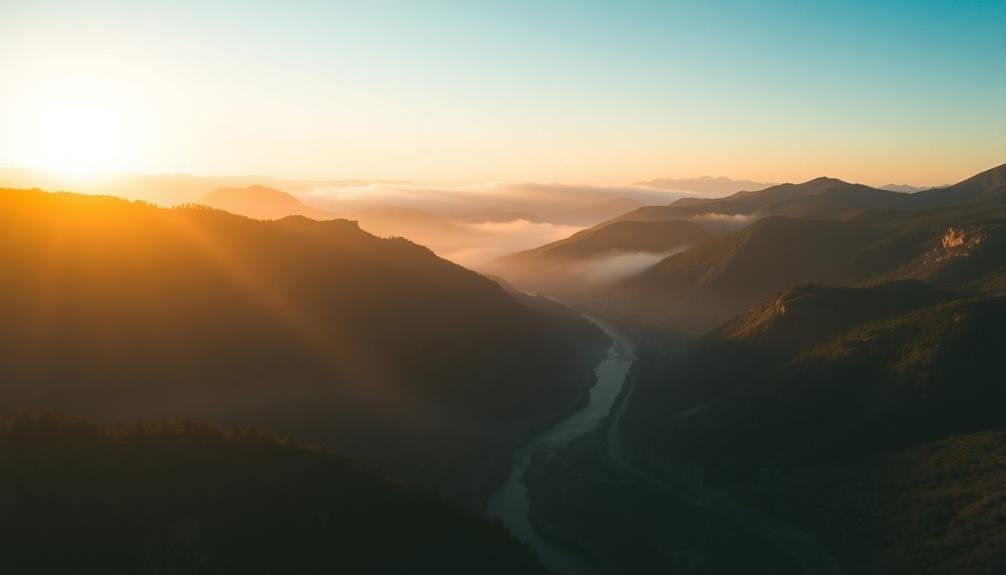
Achieving cinematic results in flyover sequences demands careful attention to your camera settings. You'll need to balance shutter speed, aperture, and ISO to create smooth, professional-looking footage.
Start by setting your shutter speed to twice your frame rate (e.g., 1/50 for 24fps) to achieve natural motion blur. Choose a wider aperture (lower f-stop) to create a shallow depth of field, separating your subject from the background.
For ISO, keep it as low as possible to minimize noise, but don't be afraid to increase it if needed for proper exposure. Use neutral density filters to maintain these settings in bright conditions.
Remember to shoot in a flat color profile to maximize dynamic range and flexibility in post-production.
Consider these additional tips for cinematic flyover shots:
- Use manual focus to prevent unwanted focus shifts
- Enable image stabilization if available on your camera or lens
- Experiment with different frame rates for varying effects (e.g., 60fps for smooth slow-motion)
- Utilize a gimbal or drone with smooth flight characteristics for steady footage
Post-Production Enhancements and Effects
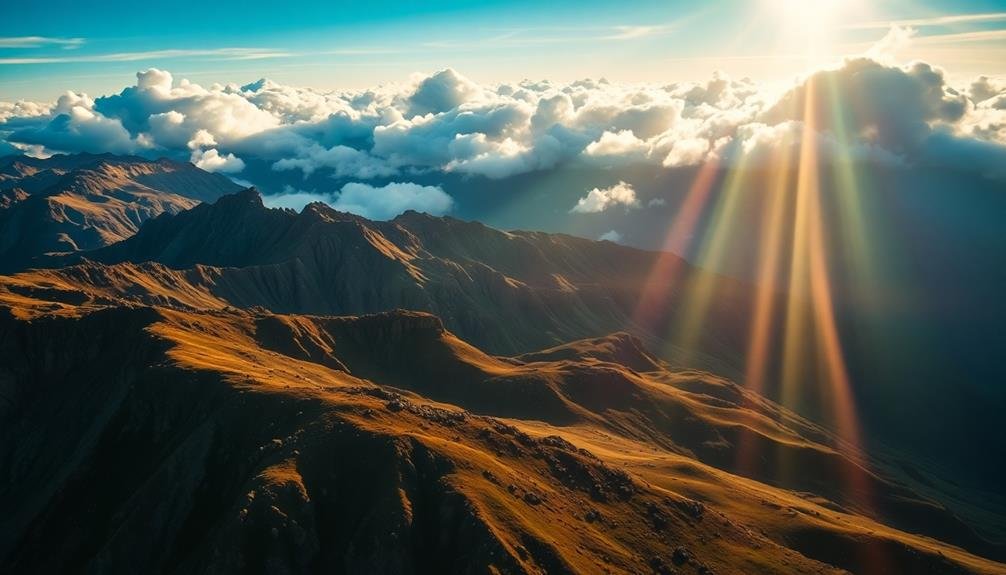
Once you've captured your stunning flyover footage, post-production work can elevate it to the next level. Start by color grading your footage to enhance its visual impact. Adjust contrast, saturation, and white balance to create a cohesive look that matches your intended mood. Consider using LUTs (Look-Up Tables) for quick, professional-looking results.
Stabilization is essential for smooth flyover sequences. Use software like Adobe After Effects or DaVinci Resolve to remove any remaining jitters or wobbles. Pay special attention to horizon lines and vertical elements to maintain a steady perspective.
Add depth and dimension to your shots with subtle motion blur or camera shake effects. This can create a more immersive experience for viewers. Experiment with speed ramping to dynamically adjust the pacing of your sequence, emphasizing key moments.
For seamless shifts between shots, try using digital zooms, pans, or wipes. These can create a fluid narrative flow throughout your flyover sequence.
Legal Considerations for Aerial Filming
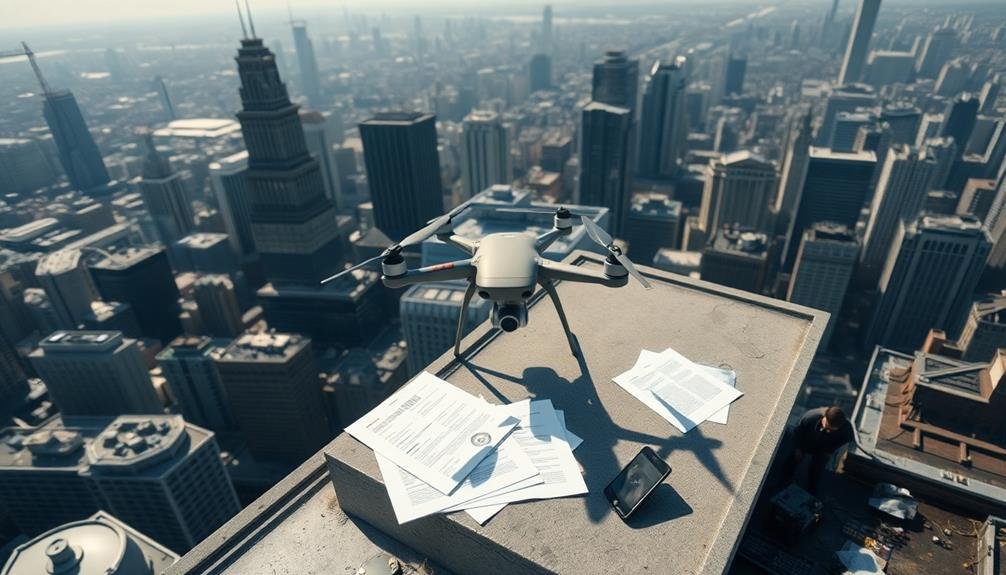
Before you take to the skies for your epic flyover shots, it's important to understand the legal landscape of aerial filming. Different countries and regions have varying regulations, so you'll need to research and comply with local laws.
In the United States, the Federal Aviation Administration (FAA) oversees drone operations and has specific rules for commercial use.
To guarantee you're operating legally, consider these key points:
- Obtain necessary licenses and certifications
- Register your drone with the appropriate authorities
- Secure permits for filming locations and airspace access
- Adhere to height restrictions and no-fly zones
You'll also need to respect privacy laws and obtain permission when filming over private property.
Insurance is vital, as it protects you and your equipment in case of accidents or damage. Remember that regulations can change, so stay updated on current laws.
By following these guidelines, you'll not only avoid legal troubles but also demonstrate professionalism in your aerial cinematography work.
Always prioritize safety and responsible flying practices to maintain a positive reputation in the industry.
Frequently Asked Questions
How Do Weather Conditions Affect Flyover Cinematography?
Weather conditions greatly impact your flyover shots. Wind can cause camera shake, while rain or fog reduce visibility. Sunlight affects exposure and shadows. You'll need to adapt your settings and timing to achieve the best results in varying conditions.
What Are the Best Times of Day for Capturing Epic Flyover Shots?
You'll get the best flyover shots during golden hour, just after sunrise or before sunset. The soft, warm light adds drama and depth. Early morning can offer misty landscapes, while late afternoon often provides stunning long shadows.
How Can Sound Design Enhance the Impact of Flyover Sequences?
You'll amplify your flyover's impact with strategic sound design. Use a mix of ambient noise, wind effects, and carefully chosen music. Don't forget to incorporate Doppler effects and dynamic volume changes as the camera moves.
What Are Common Mistakes to Avoid When Filming Flyover Scenes?
You'll want to avoid shaky footage, excessive speed, and abrupt movements. Don't forget to plan your flight path carefully. Be mindful of lighting conditions and guarantee you're following local drone regulations for safe, legal filming.
How Do You Create Seamless Transitions Between Ground and Aerial Footage?
To create seamless changes, you'll want to match camera movements, maintain consistent lighting, and use smooth speed ramps. Don't forget to align your compositions and color grade both ground and aerial footage for a cohesive look.
In Summary
You've now got the tools to create breathtaking flyover sequences. Remember, it's not just about the gear, but your vision and execution. Keep practicing your flight skills, refining your compositions, and experimenting with camera settings. Don't forget to stay within legal boundaries. With these techniques, you'll elevate your cinematography to new heights. So go out there, take to the skies, and capture those epic aerial shots that'll leave your audience in awe.

As educators and advocates for responsible drone use, we’re committed to sharing our knowledge and expertise with aspiring aerial photographers.
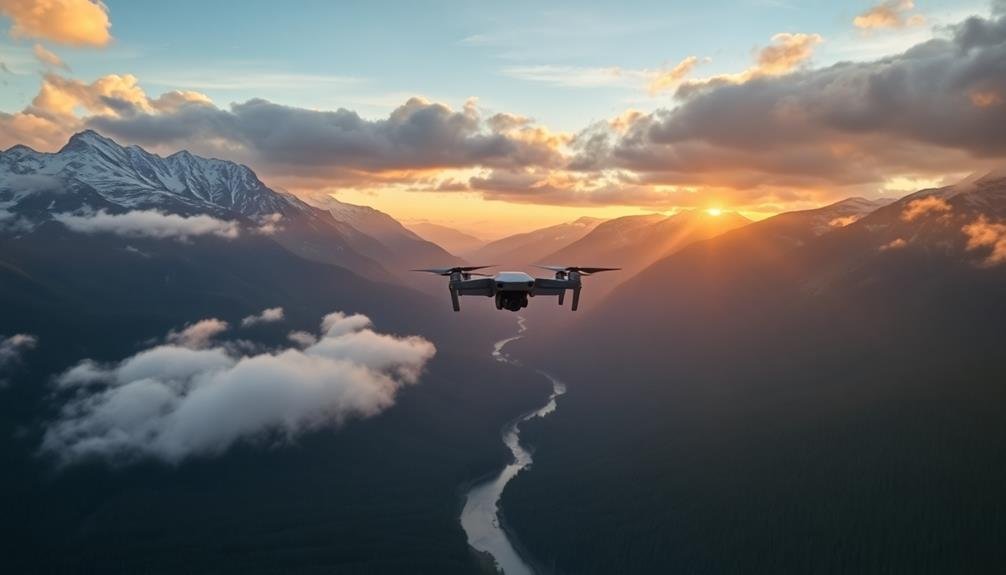



Leave a Reply